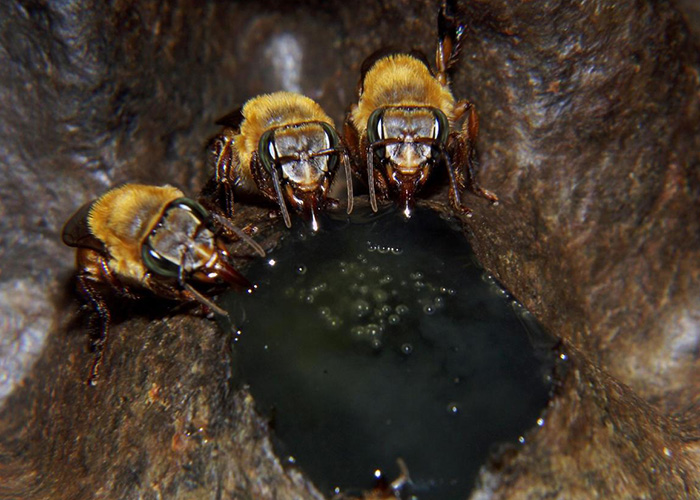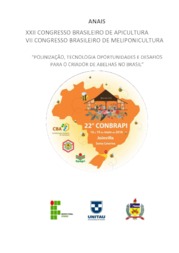Researchers assess the impact of artificial diets on the health of stingless bees
Researchers assess the impact of artificial diets on the health of stingless bees
Photo: Cristiano Menezes

Melipona flavolineata colony fed with artificial feed that was colored with green aniline for tracking
A study published in the Journal of Apicultural Research shows that artificial diets can be an interesting tool to feed the bees in adverse circumstances. But it also warns that natural pollen is far from being replaced. The ideal would be to plant more trees of different species to supply food to the insects all year round.
One of the authors of the study, Embrapa Environment researcher Cristiano Menezes, posits that better knowledge about bees is important because there are periods of the year where they do not find flowers to feed themselves, which can affect the survival of the colonies. Nectar, a source of sugars, can be more easily replaced by a syrup (an aqueous sugar solution). However, pollen, the source of proteins, vitamins, fats and minerals, is more complex and difficult to replace, as the specialist explains.
Previous studies on artificial diets with the aim of substituting pollen had shown that soy extract-based diets have good potential. However, the chemical composition of such diets and their effect on the health of the bees in the long run had not been investigated yet.
The authorsBesides the researcher Cristiano Meneses, the work published on the Journal of Apicultural Research was authored by the following scientists: Felipe Contrera, Felipe Domingues, Jamille Veiga, Joyce Teixeira and Kamila Leão, from the Federal University of Pará (UFPA); José Eraldo Fontes, Thiago Lopes and Anita Marsaioli, from the State University of Campinas (Unicamp); and Ana Carolina Queiroz, from Embrapa Environment. |
For this reason, the goal of the work was to study an artificial diet to replace the pollen. “Our experimental model was Uruçu-amarela, or Melipona flavolineata, an important stingless bee from the Amazon region as it produces one of the most appreciated honeys of Brazil”, Menezes reports. The study which today is at Embrapa Environment (Jaguariúna, SP) was initiated at Embrapa Eastern Amazon (Belém, PA) and counted on the collaboration of partners from the Federal University of Pará (UFPA) and the State University of Campinas (Unicamp).
The first step was to investigate the chemical composition of natural pollen and compare it with the composition of the artificial feed. At a second stage, the effect of this diet on the health of the bees was investigated, both at individual and at colony level.
The scientists observed that the artificial food presented quite a different chemical composition from the natural one. It is richer in carbohydrates and lipids; however, it is poor in protein in comparison with natural pollen.
Menezes reports that, despite the different compositions, his team did not find a difference in the survival of the offspring that ingested the artificial feed or in the size of the individuals. In fact, the individuals that ingested the artificial diet during the larval stage became about 5% larger than those that had natural pollen. “The only parameter [of the artificial diet] where we found a negative effect was longevity. The adult bees fed exclusively with the artificial feed lived nine days less on average than the ones that ingested natural pollen”, tells the scientist.
The search for a replacement diet
“We can assert that the soybean-based artificial diet does not fully replace natural pollen and that we will hardly find a perfect artificial diet. For future formulas, we need to reduce the quantity of sugar in the recipe and find ingredients that increase the protein content. This will bring the feed closer to the characteristics of the natural food".
Despite that, they can be an interesting complement to supply the colonies in exceptional circumstances. For example, in periods of the year with flower scarcity or in high beehive density conditions or in places with deficient apicultural pastures, like urban environments and degraded rural areas.
| It is important that beekeepers invest in planting trees |
“It is very important to stress that in order to be successful, beekeepers need to strongly invest in planting trees to increase the supply of natural food throughout the year, especially species that blossom in the period between crop harvests. This simple action will significantly contribute to increasing the productivity of the bees they manage and also help in the conservation of wild beed that cannot be raised by man ", the researcher recommends. .
Recipe for the artificial feed used in the study
Ingredients:
- 500g of soy extract,
- 500ml of syrup (water and sugar, 50% concentration),
- 50g dof natural pollen from Melipona flavolineata colonies. Using Apis mellifera (Africanized honeybees) pollen or honey in the formula is not recommended as it can transmit serious diseases to stingless bees.
Procedure:
Combine the soy extract with the syrup until you reach cake batter-like consistency. Bring the mixture to a boil stirring well, then let it cool naturally. Then add the natural pollen and keep it at room temperature.
The mix will ferment due to the action of beneficial microorganisms from the natural pollen. Stir the mixture daily. The feed will be ready for use after 15 days. It can be kept in the refrigerator for weeks and be gradually offered to the bees.
Photo: Cristiano Menezes
Translation: Mariana Medeiros
Cristina Tordin (MTb 28.499/SP)
Embrapa Environment
Press inquiries
Phone number: +55 19 3311 2608
Further information on the topic
Citizen Attention Service (SAC)
www.embrapa.br/contact-us/sac/

